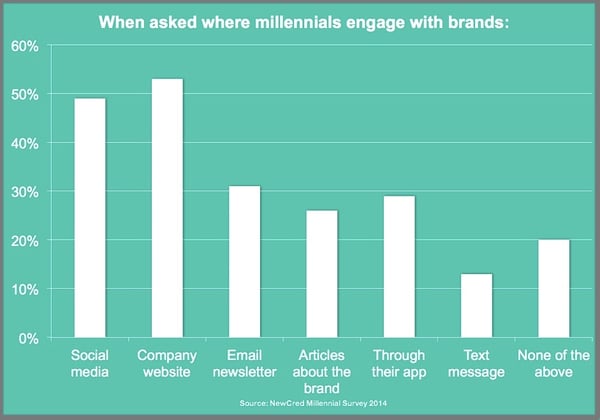Financial advisors looking to reach out to the untapped market of millennials need to start understanding where they are. There is currently a huge disconnect between financial advisors and young investors. It’s about time that financial advisors leave the traditional office setting meeting and resort to new practices of online engagement through the web using platforms such as Skype, Google Hangouts or even FaceTime. To stay relevant, financial advisors are recognizing that technology has to be a big piece of their pitch to future generations.
Did you know that the first website was only published just 25 years ago? Many businesses still have not taken the necessary steps to establish themselves and grow an online presence in this day and digital age.
WHAT IS THIS ARTICLE ABOUT?
One of the issues that the wealth management industry faces is grappling with the challenge of attracting Generation Y clients. Those in the industry who aren’t receptive to adopting these new technological changes to engage with this target audience will struggle. Financial advisors need to start embracing what this generation has to offer and take on these new opportunities when growing their client base and servicing their business with advisors. Millennials are now the largest generation in North America. That said, not managing their money is a large missed opportunity.
WHO WILL FIND THIS ARTICLE VALUABLE?
This article is meant to make financial advisors and financial professionals aware of their current situation as they look for strategies to grow their business and compete alongside other players in the industry. The focus of this article is on financial advisors who feel they’ve been missing out on potential new millennial/young clients due to not being able to connect with them.
WHAT FACTORS CONTRIBUTE TO THE LACK OF STRONG BRAND EXPOSURE AND POOR ONLINE CREDIBILITY?
Without a solid online presence, potential customers won’t be able to find your business, and/or you won’t be meeting consumers’ expectations. Thus, resulting in missed opportunities and becoming irrelevant.
The technological barriers to entry are extremely low. However, financial advisors need to follow compliance procedures and regulations. Once you achieve their approval, you still need a way to stand out from the crowd on the web.
Not Generating Enough Content

Consider this Fun Financial Fact: According to MarketingProfs, companies that publish new blog posts just 1-2 times per month typically generate 70% more leads than companies that don’t blog at all.
Before, people only had their own individual blogs. However, the rise of business blogging has become evident. If we just look at the statistics, businesses that blog receive more qualified leads, see an increase in website traffic, improve their SEO, and overall, establish themselves as thought leaders in their industry.
Blogging is not the only form of content though. There are whitepapers, e-books, webinars, educational videos, case studies, podcasts, guides and more. The trick to a successful content marketing strategy is knowing who your target audience is, grouping them into “personas” (representation of the ideal customer based on their behaviours and preferences), and providing the content they’d be interested in.
If millennials are the group you’re interested in, you should start by doing some research on them. Talk to your kids if you have any, ask your friends and their kids, or even just google to discover where they hang out online and what it is that they’re looking for when considering paying for a service. Then cater the content they’d be interested in on the channels that they’re active in. Hint: not fintech conferences!
Content is what separates one firm from another. By providing useful and thought-provoking information to potential clients, you are giving them a taste of the services that you can offer to them in both the short-term and long-term of their finances.
Lack of a Mobile-Optimized Site

Gen Xers and younger adults have completely integrated the use of mobile devices into their lives due to the convenience and ease of use features smaller devices offer compared to a regular desktop computer.
The recent “app craze” has also contributed to making pretty much every online transaction more accessible to the masses, from booking trips to money transfers. Naturally, the switch to mobile has increased exponentially and most businesses have followed suit.
The early adopters made huge gains and enjoyed massive brand exposure on mobile since some of the competition were late to act. As mobile gained popularity, tech-savvy younger generations flocked to mobile use and refused being chained to their desks.
What this meant for businesses is that in order to attract younger clients, they couldn’t afford to not have a mobile-responsive site. In other words, they had to make sure their websites worked properly on smaller devices. Which still is the case in 2017.
“Data from Phoenix Marketing International regarding affluent investors indicates that more than 50% of people under age 35 are comfortable managing their finances with mobile tools and have downloaded apps”
“It only takes 1/10th of a second to form a first impression of a person, and websites are no different” according to CXL Institute. If your website isn’t loading or even functioning properly on a mobile device, younger potential clients won’t even bother to look at any amazing services or products you may be offering. And that, spells doom for you in terms of Google’s search results ranking for your business.
No Social Media Presence

In this day and age, I’d say pretty much say that everybody is on social media. Heck, even my Dad is on Twitter! It’s time that financial advisors hone in on these opportunities and use these platforms to get ahead of the game. What social media offers you is another way to connect with your clients and be present in the places that they are. If you weren’t already using social, then maybe it’s time to you ought to be as there is an entire demographic that you haven’t gotten a chance to tap into yet!
LinkedIn can be an extremely valuable platform to use that can help showcase who you are and what you do as a financial advisor. Few tools are as effective as LinkedIn Recommendations, a reputation engine that financial advisors can use to boost their profile, attract clients and differentiate themselves from others in the industry. Sounds like a marketing gimmick? I’ll leave this here with you then: In 2012, more than 60% of financial advisors have used LinkedIn to gain new clients.
Here’s another fun financial fact for you: Did you know that 60% of a focus group of 500 financial marketers have acquired leads from social media, according to this article written by Amy McIlwain from Hootsuite.
HOW TO LEVERAGE POTENTIAL CUSTOMERS
Ok, so we know what the issue is; most advisors do not speak the same language as younger investors. They’re not in the same “online circles”. They’re disconnected. They’re traditional and reluctant to adapt to requirements of the digital age.
The reality of the changing industry is that the next generation of investors, generation x and y, are looking for an advisor with a certain level of digital experience on them. Therefore, when it comes to engaging with younger demographics, having a strong web presence is essential. Pretty soon, younger advisors may be needed to serve younger clients. This will be beneficial as they will be able to speak their language both culturally and technically.
If you are just starting up, it is important to establish yourself as a certified professional before readers begin to take an interest in your writing. Once set up, ask yourself this key question: “What should my online presence offer that others do not?” In order to maintain active engagement with your audience, realize that it is essential to understand your positioning strategy as readers are seeking content that is new, fresh and exciting. Position yourself in a way that addresses the key issues that clients in your industry are facing and showcase yourself as someone that can offer relevant, helpful advice. Regarding where to position yourself, take a look at the following chart put together by NewsCred
The gist of it is, advisors have to be active online. There’s no work-around. Take a look at these useful statistics and decide for yourself:
- Roughly 5 million U.S. and Canadian high-net-worth investors actively use social media to help them make financial decisions. (https://goo.gl/McccPH)
- In 2012, more than 60% of financial advisors have used LinkedIn to gain new clients. (http://linkd.in/YaTQuf)
- Of that group, 32% used LinkedIn to bring in $1 million or more in assets under management. (http://linkd.in/YaTQuf)
- 71% of advisors say their target clients are active on LinkedIn. (http://linkd.in/YaTQuf)
- Slightly more than one-third of US online adult Twitter users agree with the statement “I often recommend financial products and firms that I like to my friends and acquaintances,” compared with 21% of US online adults overall. (http://bit.ly/eO5fki)
- 75% of senior executives watch videos on business sites every week. 65% go on to visit a vendor’s website after watching a video. (Earnest Agency)
- 45% of online US adults who have a Twitter account are interested in interacting with financial services firms via Twitter. (http://bit.ly/eO5fki)
NEXT STEPS FOR ADVISORS WILLING TO “UP THEIR GAME”
First and foremost, advisors need to understand where all the aforementioned online activities converge: your website. You post a blog article, you want readers to go through your services/offers after they’re done. You post something on social media, you want viewers to click it and be taken to a landing page where they’ll express interest to initiate dialogue.All of this and more are connected to your website. It all starts with a modern, easy-to-navigate, mobile friendly website that conveys expertise and credibility. A good place to start looking into that is right here.
Once you have the website built and published, you need to look at some channels on which to start engaging with younger investors. These channel include social media (notably LinkedIn, Facebook and Twitter), blogs, discussion boards (e.g. Reddit and Quora), videos, podcasts, content sharing platforms like Medium and more.
As John Dewey put it; “a problem well put is half solved.”. You already know why you’re missing out on younger clients now. With a little bit of strategizing, you can easily turn that around and put yourself ahead of your competition.










